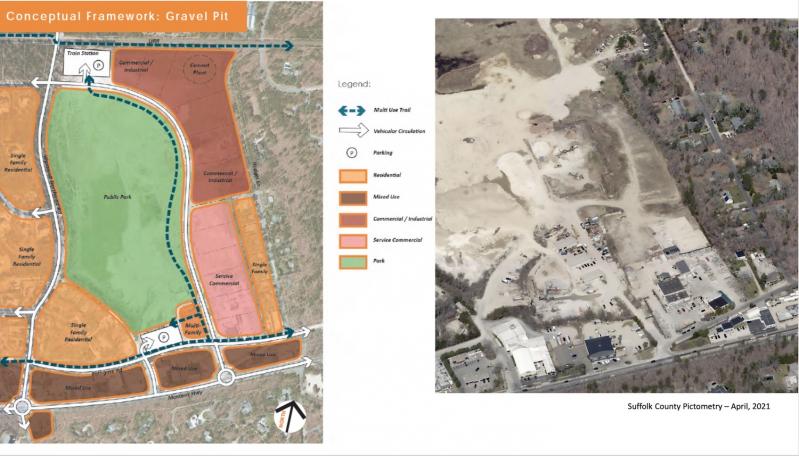The working group to implement recommendations for the Wainscott hamlet study reconvened on March 2, with progress still frustratingly slow for some participants but also with some consensus achieved for readily achievable goals, as well as actions to be avoided.
Consultants to the town conceded that frustration has grown over inaction after several years of study and a blueprint that was incorporated into East Hampton Town’s comprehensive plan in 2019.
Twelve members of the group responded to a poll taken after the first meeting, on Jan. 27. Among the comments were a need for more imagination to transform the “ ‘60s-style strip development,” as Pat Trunzo referred to the hamlet’s downtown at last week’s meeting. Implementation should start with what makes a place beautiful, as in East Hampton Village, and not with traffic roundabouts and new roads behind stores, is how one respondent put it.
The group’s highest priority is apparently the proposed redevelopment of the former sand and gravel mine property. A proposed 50-lot subdivision was deemed a nonstarter that would clash with the town’s environmental goals. The property should be acquired for parkland and moderate-income housing, according to the poll results. But comments also included a wish for no more residential development of any kind, affordable or market rate, and an implementation of a carbon tax for houses greater than 10,000 square feet.
The group is generally not in favor of roundabouts on Montauk Highway, believing that a decision should be postponed pending the outcome of changes at East Hampton Airport and the former sand mine. “Roundabouts work well in Europe, but not here,” was one summary of the poll.
Instead, the group’s priority actions include the installation of a continuous sidewalk along Montauk Highway, and an estimate of $190,000 was given for replacement of about 1,120 linear feet, or one-third of the commercial core. This would resolve cracking and vertical discontinuities and replace eight of nine ramps that appear noncompliant with the Americans With Disabilities Act, the group was told. Burial of power lines was also sought, along with municipal parking and a decentralized community wastewater system, among physical improvements.
The consultants, Lisa Liquori, Peter Flinker, and Ray DiBiase, suggested, and the working group agreed, that the planting of trees along Montauk Highway was one immediately attainable action.
Esperanza Leon pointed to East Hampton Village and its mature trees positioned between Main Street and its sidewalks. “It would be more agreeable to have trees on the highway side,” she said. Pedestrians would feel “less exposed by having a tree barrier,” rather than a sidewalk with no buffer between it and the street.
But these could not be planted directly underneath power lines, and there is sentiment to bury those lines. Trees should not be planted before a full plan has been decided upon, said Doreen Niggles, who suggested that money from the community benefits package to be paid by the developers of the South Fork Wind farm be allocated to that end.
Parallel parking on Montauk Highway was also debated, though that would require moving a bicycle lane elsewhere. Such a scheme, however, would constitute “taking your life in your hands” on the congested road, Ms. Niggles said.
Councilwoman Sylvia Overby felt that any additional width on the roadway should be given over to green space, or a combination of green space and parking.
One thing missing from the plan is “a unified treatment,” Mr. Flinker said, a “unified streetscape design” that conveys “a continuous place” and encourages walking. He and Mr. DiBiase showed slides depicting places UpIsland and in Massachusetts that included, in the case of Wakefield in that state, a historic structure used as a branding effort.
Ms. Overby, the town board’s liaison to the group, spoke up. “I think we’re losing sight here,” she said. “Signage is okay, but we don’t need to be branded; we’re already branded. Any sign that brands us invites even more people here. . . . We want to take care of the people already here. I don’t want to get off track, and I think we’ve gotten off track here.”
Others enthusiastically agreed. “Less is more,” Ms. Niggles said. “The less we have of all the paraphernalia, the more of Wainscott will shine through.”
The examples shown, Mr. Flinker said, were not recommendations for Wainscott, but rather to show what is typically included in a streetscape. He asked that members take pictures of existing features in the hamlet that exemplify what should be accentuated. These could be shared and debated at the group’s next meeting, he said.




